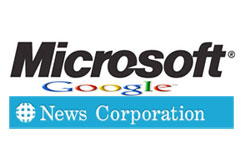Here’s today’s AdExchanger.com news round-up… Want it by email? Sign-up here.
 Murdoch-Microsoft Machinations
Murdoch-Microsoft Machinations
In an effort to undermine Google’s search dominance, Microsoft is reportedly in discussions with News Corp to be the only search engine allowed to index News Corp content. That’s over the top – let’s take it a step further. What if Microsoft was able to buy off the indexing of Wikipedia, for example, a core part of Google’s search results? Crippling for Big G? Where would they find the authority central to their search algos? The Financial Times’ Matthew Garrahan and Richard Waters report that News Corp isn’t the only publisher that has been approached either. Is this new revenue a savior to the flagging newspaper industry? Stop the presses!
Warning: New AOL (Aol.) Logo
The Tim Armstrong-inspired makeover continues at AOL as “Aol.” has arrived as the company’s new logo. Stuart Elliott of The New York Times covers the funky new spelling in the logo “Aol.” (with the dot, Aol. effectively joins the creative punctuation club created by Yahoo!) and says, “Although the AOL logo itself will be constant, the backgrounds will change continuously in an effort to suggest the breadth of AOL’s content.” Feel the breadth here.
More CPM Growth!
Adify is the latest ad technology company to come out with a research piece that shows indications of a turnaround in the display ad market. In its Quarterly report, Adify says that the “Food” category is just one vertical showing improvement as Q3 CPMs opened a can of whoop ass on Q2 2009 with a near doubling of CPMs from $3.63 to $6.94. Read the release. Or, download the report (PDF).
DSPs Need Premium
On his Stream of Consciousness blog, Pete Kim says that DSPs have to use guaranteed AND so-called remnant inventory to be truly successful. He writes, “If your DSP plans to optimize only against a secondary set of inventory, then prepare for a rude shock when you match up results against a DSP that can optimize against both premium and non-premium inventory.” Read it.
For Long Tail Lovers
The Nielsen blog covers recent research by Billboard on the power of the Long Tail. The findings provide a few interesting nuggets including: “As more digital albums are released, the more popular titles lose market share to the less popular titles. In other words, demand has shifted from the hits to the niches. The head (what Anderson would call the top 5,000 titles) has lost market share to the tail (all other albums). The head accounted for 77% of digital album sales in 2005. By 2008, the head’s market share had steadily dropped to 65%.” Read about it.
RMX Housecleaning
ClickZ’s Zach Rodgers reviews Right Media Exchange’s recent re-positioning and looks specifically at the imminent house-cleaning of second and third tier ad networks. Yahoo VP/GM tells Rodgers that its going to be a “percentage number [which] would overwhelm people,” but added, “We’re preserving the liquidity that counts.” Read the article.
FM Talks DoubleClick Ad Exchange
Farney Media has an in-depth interview with Kate Herbert, Senior Manager of DoubleClick Ad Exchange Global Services. Herbert sheds light on the European adoption of the Google DoubleClick Ad Exchange and looks at the specifics of real-time bidding on the Ad Exchange among other topics. Read it here.
Ms. Internet
Fresh from the latest Dave Matthews Band concert, Varick Media’s Darren Herman shares a frank conversation with “Ms. Internet” on his blog. In a clever narrative provoked by the sometimes beguiling opportunity posed by innovation on and through the Internet, Herman tells the story of a complicated lass. Meet her now.
Living With Data
Paul Kedrosky points to a video from a recent TED India Talk by MIT grad student Pranav Mistry who talks “about living with data, including such stuff as coffee cups that can help you find coffee.” There is a nutty moment in this video (half-way through) where Mistry uses his fingers to take a real picture. See it.
Designing The User Interface
Andrew Chen takes note of recent discussion on the Agile Development blog about best practices for user interface design that can stay ahead of the engineers and the fast-moving, iterating agile development process. Among the tips, “Prototype in low fidelity.” Read Agile.
160 Characters Or Less
Yes, Virginia, audience can be targeted in 160 characters or less. Pamela Clark-Dickson, an analyst at Telecoms.com, looks at what may be Google’s next acquisition target – an SMS advertising company. She lists several possibilities including 4INFO, iLoop Mobile and HipCricket “depending on whether Google is going to continue to focus purely on SMS advertising, or whether it enters the mobile marketing industry sector.” Read more.
Modeling Mobile
Brent Halliburton offers CPM models for two mobile ad networks, AdMob (bought by Big G, of course) and Millenial Media (which recently raised $16 mil). Halliburton says, “In the interests of being conservative, let’s make the mobile network CPMs $0.25” and posits that 50-person Millenial’s revenue model may be a lot closer to break even than 150-person AdMob’s. Read it.
Boston Vs. Silicon Valley
Boston Globe Correspondent, Scott Kirsner, responded to a recent declaration by entrepreneur Vivek Wadhwa on TechCrunch that Silicon Valley has left Route 128 (Boston) in the dust. Kirsner finds Wadhwa’s argument that having to choose between 3 tech events in a day does not mean superiority. Read more.
Out-ing Attribution
ClearSaleing concludes its 10-part, blog post series on Attribution with a blog post on “Basic Attribution Models, Mathematical Attribution & Data Warehousing.” ClearSaleing’s Adam Goldberg (AdExchanger.com Q&A) offers the following among many tips around data management: “To harness this information and to make it actionable, it will require the use of a data warehouse, which can be a powerful marketing intelligence asset for your company.” Read the entire series.












